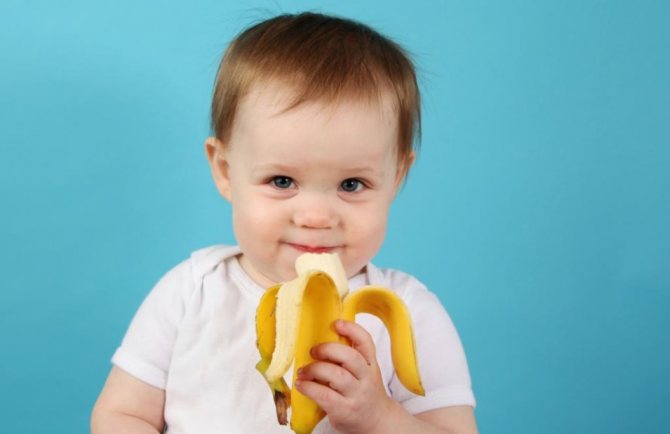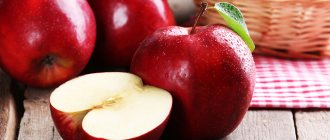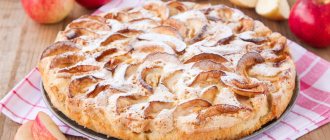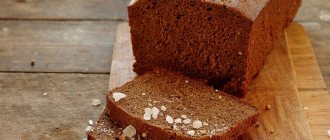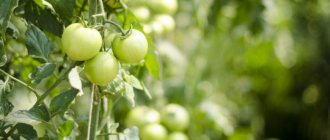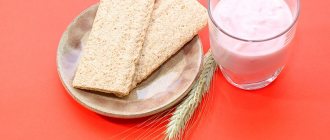How many calories are in 1 banana without peel and 100 grams?
Do bananas contain calories and how many kcal (kilocalories) are in one banana? These questions are asked by those who are planning a diet that necessarily includes various types of vegetables and fruits. Despite the fact that this fruit is considered a healthy delicacy, with a healthy diet it is recommended to carefully consider its caloric content and energy value.
Banana is considered one of the most high-calorie foods
When calculating calories for a day, you need to know: the calorie content (energy value) of one banana without peel (skin) is 120 kcal for an average fruit . The phrase “average fruit” is key here: bananas, like other fruits, differ in varieties and growing conditions, and therefore their energy value can vary significantly. For an overripe fruit (with brown spots and rare dark stripes on the skin) the calorie content will already be 180 kcal - the equivalent of the energy value of 100 g of boiled chicken fillet.
The number of calories in a banana (1 piece) – 110…180 kcal
Baby bananas, sold in attractive bunches in supermarkets, contain 80–90 kcal due to their small size. Slightly sour bananas of the rather rare, “green” variety Platano are distinguished by their low calorie content - about 60 kcal per fruit.
Brief description and history of the plant
Southeast Asia is considered the birthplace of these tropical fruits.
And now their wild ancestors are found there - small greenish fruits with large seeds. A little later, the plants were brought to Africa and America.
Modern bananas sold in stores are obtained by cultivating plants that grow in nature.
Banana plants are properly called grass because the shoots grow, produce flowers and fruit, and then die. Despite their gigantic growth (5-15 m), they do not have a woody stem.
Banana is a vegetable, fruit or berry
From the point of view of botanical scientists, a banana is a berry, since it is a small fruit of a plant that, by its characteristics, is a grass.
However, in everyday life it is considered to be a fruit, because the cultivated varieties sold in stores are more similar to it and have a sweet taste.
Where and how they grow
The main condition for the growth of this crop is a hot climate, so bananas are grown in countries located near the equator.
The banana plant has powerful roots and a stem on which huge leaves are located.
The clusters contain up to 300 fruit specimens.
The main suppliers of fruits are the countries of Latin America and Africa.
Varieties
All varieties of banana plants are divided into 3 groups:
- decorative;
- plantains;
- dessert.
Ornamental varieties are inedible, but they have beautiful flowers.
Plantains are fruits that require heat treatment. Only after this they are eaten.
Dessert fruits are those that can be eaten raw.
Calorie content 100 gr. cottage cheese with banana (1 piece) without peel
Of course, not everyone can handle eating the same product in its pure form every day, and there’s no need to: among people there are both real banana eaters and those who are more than indifferent to these fruits. The banana menu can be diversified by adding cottage cheese casseroles, kefir, yogurt or regular cottage cheese - the calorie content is calculated as the sum of the kcal components of the products :
- banana with yogurt – 135 kcal;
- kefir with banana puree – 60 kcal;
- cottage cheese with banana – 190 kcal;
- but the cottage cheese and banana casserole will be much less high in calories - only 100-105 kcal.

Waffle with banana pieces and grain curd
Benefits and uses of banana peel
When consuming fruit peels, do not forget that to preserve the fruits, they are treated with chemicals. Before using the banana skin, it must be thoroughly washed and doused with boiling water. After this treatment, the peel can be used in the same way as the pulp, because it contains the same nutrients, plus plenty of fiber. Cocktails and smoothies are made from it, and used in baking.
In addition, the peel is a valuable fertilizer for the garden, vegetable garden or indoor plants. An infusion is made from it, which is used to water the ground.
You can put a piece of peel at the bottom of a pot with an indoor flower.
How many calories are in one medium dried banana without peel?
Banana is a very diverse berry, which is good both in its pure form and with cocoa or sour-milk products. Many people prefer these fruits in dried form as a nutritious snack, believing that this form is healthier for the body. However, a dried (dried) banana product is still a “fruit”: its calorie content is almost twice as high as the energy value of a fresh overripe fruit.
Calorie content 1 pc. dried banana is about 100 kcal
When calculating a dietary menu, it is necessary to take into account that the weight of an average dried banana is, for obvious reasons, lower than the weight of a fresh one and amounts to 25–35 g. One such dried fruit can satisfy hunger for several hours with a snack, but, of course, it can be used as a low-calorie dietary product for weight loss. can not.
Properties of banana
Since childhood, many people have regarded the banana as their favorite fruit, but they have never thought about how easily it can be used to significantly improve their health.
The thing is that the potassium contained in the pulp of the fruit perfectly rids the body of excess water, and iron helps to increase hemoglobin blood levels. Enveloping the walls of the stomach, fiber causes relief from stomach ailments. The ubiquitous magnesium helps in the functioning of the heart and brain.
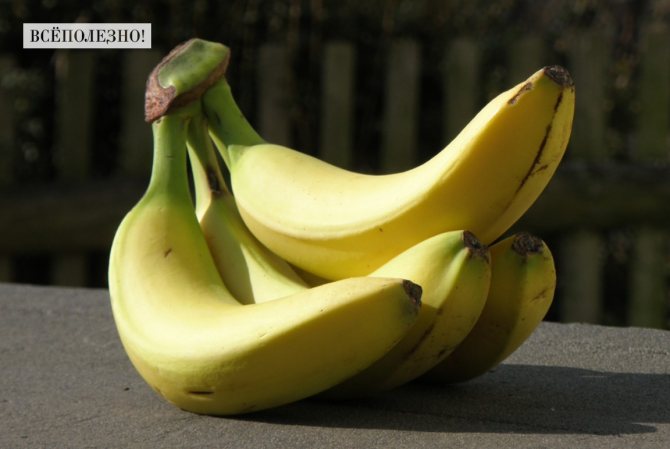
The fruit increases concentration and improves attention in humans, affects performance and information perception. Increases the building of muscle tissue, focuses on enhancing the strengthening of the immune system, which makes it easier to fight viruses and bacterial confrontations.
Benefit
The beneficial qualities of a banana are determined by its nutritional properties and the presence of large quantities of important microelements and vitamins. The fruit is superior in value to the apple. From a couple of fruits you can easily get your daily requirement of potassium. Tropical daring has a large number of active substances.
Malic acid found in bananas takes an active part in the digestive system and affects the absorption of hydrocarbons. The fibers of the fruit are gentle on the stomach and therefore the fruit is recommended for patients with abnormalities in the digestive tract, suffering from gastritis.
For people suffering from frequent swelling, doctors advise using the fruit more often as a dessert. Bananas are excellent for removing excess water from the body. Cosmetologists often use the fruits as face masks.
Harm and contraindications
According to many studies, scientists have come to the conclusion that eating fruits cannot cause any harm. Only individual indications for a person are possible. All food, like a banana, should be consumed by a person - in moderation, and then no threats are terrible.
Like other tropical fruits, banana is not recommended for children under three years of age. According to genetics, in children the digestive system is not yet fully formed, so the body is able to respond with an allergy to the product.
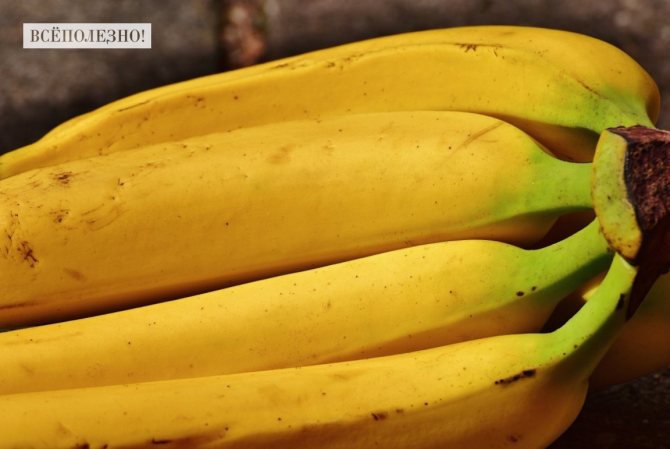
Bananas are not recommended for overweight people. Eating them requires early consultation with a gastroenterologist. This is due to the high calorie content of the fruit and, following its recommendations, intake of the fruit should be limited, or be included in the list of exceptions from the human diet.
Undesirable consumption of the fruit includes people with thrombophlybitis and cardiac ischemia. Anyone who suffers from high blood clotting is included in their number. When water is removed from the body, blood thickening begins, which threatens to worsen the health of the body.
Calorie content (nutrition value) 100 gr. banana chips
A priori, banana chips fried in oil cannot be lower in calories than fresh fruits - and so they are: their high calorie content makes this product unsuitable for a diet menu; they contain:
- proteins – 9–10 kcal;
- fats – 300–310 kcal;
- carbohydrates – 200–205 kcal.
So, we calculate how many calories are in 100 grams. banana chips? Receives 510–525 kcal . A small bag of such a product is comparable in calorie content to a full meal.
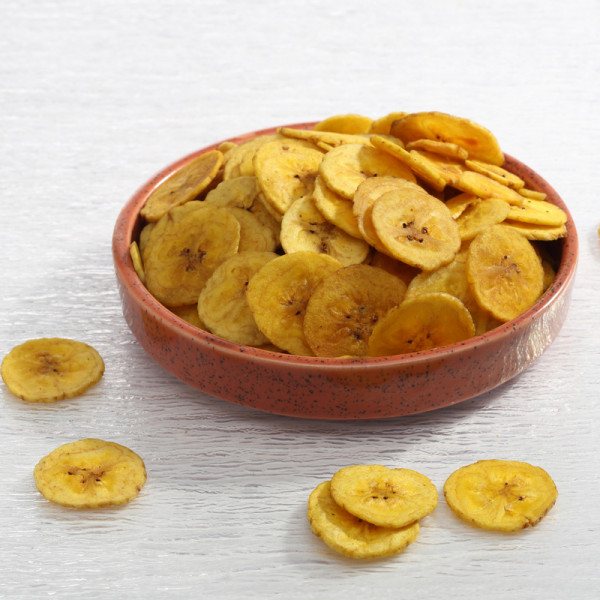
Banana chips are high in calories
Banana peel: benefit or harm?
Slipping on a banana peel is the biggest harm it can cause. Banana peels are not poisonous and are in fact full of nutrients and are edible. According to Flores, “In many parts of the world, banana peels are used for cooking, although this is not common in the West. It contains high amounts of vitamins B6 and B12, magnesium, calcium, fiber and protein.” An article was published in the journal Applied Biochemistry and Biotechnology in 2011, according to which banana peels, among other things, contain “various biologically active compounds, such as polyphenols, carotenoids and others.”
Before eating banana peels, you should wash them thoroughly, as various pesticides are often sprayed in banana groves.
Typically, banana peels are served cooked—boiled or fried—but are sometimes eaten raw or added to a blender with other fruits. It doesn't taste as sweet as the banana itself. The skin of the ripe fruit may be sweeter than the green skin.
How many proteins, fats and carbohydrates (BJU) are in one banana without peel and in 100g of banana?
Let's move on to another indicator of nutritional value - BZHU: the ratio of proteins, fats and carbohydrates. When drawing up a dietary menu involving banana fruits, many questions arise: does a banana contain protein, how many carbohydrates are in 1 banana and in what form should it be consumed so that it is as beneficial as possible for the body?
Composition of banana BJU per 100 grams:
- proteins – 1.5 g (6 kcal);
- fats – 0.1 mg (5 kcal);
- carbohydrates – 21.8 g (84 kcal).
An important indicator is how many grams of proteins, fats and carbohydrates are in a banana (1 piece):
- proteins – 2.5 g;
- fats – 0.2 g;
- carbohydrates – 32 g.
The data is based on the average weight of a fruit of average maturity.
The optimal ratio of proteins, fats and carbohydrates (by weight) for a banana is: 16%, 17%, 67%
Nutritional value, composition and calorie content of bananas
One medium fruit contains about 105 calories, most of which come from carbohydrates.
100 grams of bananas contain (% of recommended daily intake) (1):
- Calorie content: 89 kcal (4%).
- Carbohydrates: 22.8 g (8%).
- Fiber: 2.6 g (10%).
- Fat: 0.3 g (1%).
- Protein: 1.1 g (2%).
- Vitamin C: 8.7 mg (15%).
- Vitamin B6: 0.4 mg (18%).
- Folic acid: 20 mcg (5%).
- Potassium: 358 mg (10%).
- Manganese: 0.3 mg (13%).
- Omega-3 fatty acids: 27 mg.
- Omega-6 fatty acids: 46 mg.
How much does one medium banana weigh without peel?
To recalculate the indicators indicated per 100 g of product, you need to know how much a banana without peel weighs on average. Weight 1 pc. is 150 grams . The average unpeeled fruit weighs 200g, with the banana peel weighing approximately 50g, accounting for a quarter of the total weight. Knowing the average weight of one banana without peel is necessary when preparing complex dishes, banana cookies, desserts, cocktails, etc.
Naturally, few people buy one banana in the store - a bunch is stored longer, and the healthy product is on hand for more than one day. How many bananas are in 1 kg? Again, if we take into account the average fruit weight (200 g with peel), then there will be five of them in one kilogram .
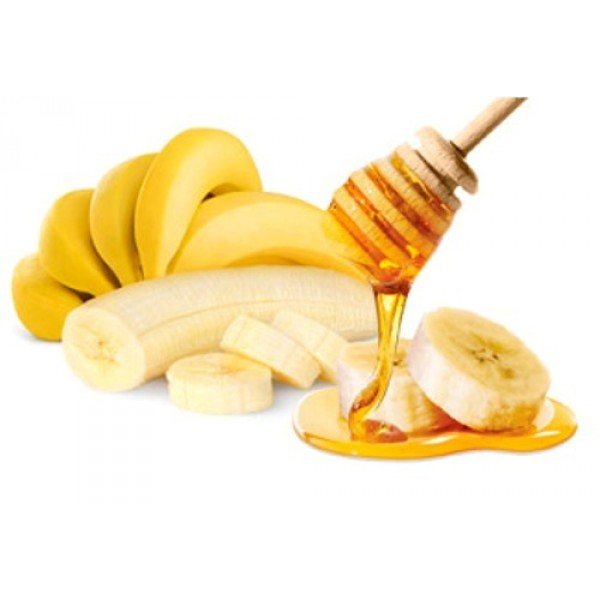
Bunch of ripe bananas and honey
Use of bananas in cooking
Most often they are eaten raw. They are soft, sweet and very tasty when ripe. This is an excellent addition to cottage cheese, fruit salad or ice cream. Bananas are fried, baked, dried, and added to smoothies.
They are used as a filling for muffins, pies and other baked goods. In one Krasnodar cafe they once baked peeled bananas in puff pastry. It was delicious. Why they stopped doing it is a mystery.
Flour is produced from the dried pulp, but it is difficult to squeeze out the juice. It turns into a cloudy puree.
Banana pancakes
Tender, nutritious, healthy... Ideal for Sunday breakfast. They are prepared instantly, and the pleasures are a carriage and a small cart.
Ingredients:
- any fermented milk product – 450 g,
- 2 ripe bananas,
- a pinch of salt,
- teaspoon of soda,
- 30 g table vinegar,
- 50 grams of vegetable oil,
- flour - 1.5 cups.
Preparation:
- Mix the ingredients in a blender until smooth.
- Add flour.
- Heat the frying pan.
- Grease the surface with a piece of lard, pricked on a fork.
- Scoop the dough into a ladle, pour it into the pan, and spread it over the surface.
- Fry on both sides, carefully turning over with a silicone spatula.
- Place the finished pancakes in a stack. Brush each one with melted butter.
Serve the pancakes hot, topped with sour cream, “cold jam” from feijoa or raspberries grated with sugar.
Rice with fried bananas
I like to cook it for breakfast or dinner. If you cook the rice in advance, then the other “dances” will take at most 5 minutes.
You will need:
- a glass of cereal,
- 1.5 glasses of water,
- 2 slightly unripe bananas
- a pinch of hot red pepper,
- butter – 50 g,
- salt.
Preparation:
- Cook the rice. It’s better in a slow cooker, then it will retain its shape better. Let it cool slightly.
- Peel the bananas and cut into slices 1-1.5 cm thick.
- Melt the butter in a frying pan.
- Fry the pieces on both sides, turning them over with a spatula or fork.
- Once browned, sprinkle with pepper.
- Place rice.
- Stir gently and remove from heat.
Simple, tasty, affordable! Nourishing and original - what else do you need after a working day? You can do it without pepper, but then it’s not the same “calico”. And so it turns out something completely unique.
Do bananas make you fat?
In fact, the answer is not so clear, even if we take into account the high calorie content of this herbal berry. There is an opinion that due to the high carbohydrate content, you can gain weight from bananas - indeed, a fruit rich in carbohydrates quickly causes a feeling of fullness , however, if you do not eat kilograms of bananas day after day, extra pounds are unlikely to form.
The myth that bananas make you fat is based on the very high calorie content of the product, but it should be taken into account that in addition to the presence of 110–150 kcal in an average banana, it is valuable in other easily digestible substances :
- minerals and vitamins;
- quickly “burn out” in the body and give a boost of energy for the whole day with glucose, sucrose and fructose;
- malic acid and special enzymes, invaluable for the absorption of carbohydrates.
With a rationally structured diet, you will not be able to gain weight from bananas. In addition, this particular berry of herbaceous origin is approved by nutritionists for chronic gastritis and stomach ulcers .

Dessert: fried bananas with whipped cream
Benefit for health
Cardiac health
Bananas are good for your heart. They are rich in potassium and electrolytes, which provide the electrical charge needed to keep the heart pumping. According to the US Food and Drug Administration, high potassium levels and low sodium levels also protect the cardiovascular system from high blood pressure.
Animal tests conducted by the University of Alabama in 2017 showed that the potassium found in bananas also benefits blood pressure; the more potassium, the lower the likelihood of atherosclerosis. During the study, it became clear that those mice whose potassium content was reduced in the body suffered from hardening of the arteries. In humans, the disease is associated with heart disease.
Mood and depression
Bananas can help combat depression "due to their high levels of tryptophan, which is converted into serotonin in the body and lifts your mood," says Flores. In addition, vitamin B6 improves sleep, and magnesium helps relax muscles. It is worth adding that the tryptophan contained in bananas is known for its beneficial effect on the quality of sleep.
Digestion and weight loss
Bananas have high levels of dietary fiber. One banana provides 10% of your daily fiber requirement. According to Flores, vitamin B6 reduces the risk of developing type 2 diabetes and promotes weight loss. Simply put, bananas are a great option for those who want to lose weight, as they are filling and sweet in taste, and help combat hunger.
Bananas are rich in starch (a type of dietary fiber), which has piqued the interest of researchers. In 2021, the journal Nutrition Bulletin published a review that found the starch in bananas may support gut health and control blood sugar levels. Starch increases the production of short-chain fatty acids in the intestines, which are necessary for its proper functioning.
Training
Bananas may be more effective than sports drinks for replenishing energy and electrolytes. In a 2012 study published in the journal PLOS One, researchers observed male athletes who competed in a long-distance race. One group drank Gatorade every 15 minutes, while the other had bananas and water. The study showed that the final result, as well as the physical condition of the athletes, were the same in both cases. But the serotonin and dopamine found in bananas improved antioxidant capacity and helped cope with oxidative stress, improving overall performance.
Vision
It is believed that carrots are the best for helping our eyesight, but bananas are far from in last place. According to the National Institutes of Health, fruits contain small amounts of the very important vitamin A, which is so important for maintaining good vision and is responsible for the quality of vision in the dark. Vitamin A contains compounds that protect the membranes around the eyes, and protein gives brightness to the corneas. Like many other fruits, bananas help prevent macular degeneration (an incurable disease that makes vision blurry).
Bones
Bananas may not have much calcium, but they are still important for strong bones. According to a 2009 article published in the journal Physiology and Biochemistry, bananas are rich in fructooligosaccharides. These are difficult-to-digest carbohydrates that aid digestion and increase the body's ability to absorb calcium.
Cancer
According to some reports, moderate consumption of bananas can prevent kidney cancer. A 2005 Swedish study found that women who consumed more than 75 servings of a variety of fruits and vegetables reduced their risk of kidney cancer by 40%. The effectiveness of bananas was especially noted. Women who ate 4-6 bananas per week achieved a 50% reduction in risk.
Bananas may be beneficial in preventing the risk of kidney cancer due to their high levels of antioxidant phenolic compounds.
Pregnancy
A study conducted by the Royal Society found that women (740 women were examined) who ate bananas during pregnancy were more likely to give birth to boys. It was found that this effect is achieved thanks to potassium.
Thanks to magnesium and tryptophan, bananas help prevent gestational diabetes, which causes lack of sleep during pregnancy, according to a meta-analysis published by the journal Sleep Medicine Reviews.
Health Risk
There have been no known side effects from bananas, provided they are eaten in moderation, of course. Too much fruit can cause headaches and drowsiness. According to Flores, headaches may be caused by "amino acids that dilate blood vessels." Overripe bananas contain a large amount of amino acids. "Drowsiness may occur due to high amounts of tryptophan." In addition, the magnesium contained in bananas also relaxes muscles: sometimes this is beneficial, sometimes not.
Banana is a sweet fruit, so eating too much without proper oral hygiene can lead to tooth decay. Bananas do not contain enough fat and protein, so they should not be considered a separate meal, they will not be effective after a workout.
Bananas can pose a health hazard only in large quantities. The USDA recommends that adults eat two servings of the fruit per day (2 bananas). If you eat 10 fruits daily, there may be a risk of hypervitaminosis.
Excess calcium can lead to hyperkalemia, which is characterized by muscle weakness, temporary paralysis and an irregular heartbeat, according to the University of Maryland Medical Center. Serious consequences are possible, but to develop hyperkalemia you need to eat 43 bananas at once.
According to the National Institutes of Health, consuming more than 500 mg of vitamin B6 per day can cause nerve damage in the arms and legs. But to achieve an overabundance of vitamin B6, you would have to eat about a thousand bananas.
How much sugar is in one banana?
high-sugar foods and therefore cannot be recommended for a low-calorie diet:
- 100 bananas contain 12.23 g;
- ripe banana (1 piece) contains 12–16 g of sugar.
With proper nutrition, bananas, in turn, maintain optimal blood sugar levels, stopping attacks of uncontrolled hunger.
Each banana, depending on the variety and weight, contains two to two and a half teaspoons of sugar.
Beneficial features
We found out how many carbohydrates are in 1 banana - it’s time to discuss other characteristics of the product! Let's not stop, let's rather discuss why the fruit is so good and why it is worth eating - here is a list of useful qualities:
- Strengthens the immune system, counteracts colds and viral diseases;
- Removes unnecessary cholesterol;
- Stimulates hemoglobin production;
- Strengthens the nervous system;
- Improves vision;
- Normalizes metabolic processes;
- Relieves stress and improves mood;
- Increases performance, replenishes energy reserves;
- Raises blood glucose levels;
- Reduces physical fatigue, increases endurance;
- Improves memory;
- Normalizes blood pressure;
- Reduces the risk of developing cancer, strokes and heart attacks;
- Prevents premature aging of tissues;
- Prevents the development of anemia;
- Accelerates blood microcirculation, improves blood flow;
- Normalizes digestion, improves the functioning of the gastrointestinal tract;
- Strengthens reproductive function in both men and women;
- Normalizes water balance, smoothes wrinkles.
If you think about it, it's a versatile fruit that everyone can eat! Women will find their benefits - including pregnant and lactating women, men and children, those losing weight and athletes.
We also recommend: Lack of magnesium in the body: symptoms in men
You already know how many calories and carbohydrates are in a banana, but this is not the main thing - the beneficial qualities of the product are manifested thanks to its rich chemical composition! What elements does it include? Let's figure it out:
- Potassium and calcium;
- Magnesium and phosphorus;
- Iron and selenium;
- Zinc and sodium;
- Vitamins B1, B2, B5, B6, B9, vitamin K, E and PP, vitamins A and C;
- Choline and beta-carotene;
- Natural sugars and fiber;
- Starch and pectin.
Finally, we note that it is best to eat bananas after the main meal, but not earlier than an hour later. After this, refuse to eat for half an hour, do not wash down the fruit with water. This way you will get the maximum benefit and not face any unpleasant consequences! Let's discuss in a little more detail how to eat fruit correctly - especially since you already know how many carbohydrates are contained in a banana

Is there starch in banana?
Depending on the state of banana ripeness, the proportion of starch in it is different:
- unripe, green bananas are rich in insoluble, resistant starch - this substance is not digested in the small intestine of a person, but undergoes a fermentation process in the large intestine, causing increased gas formation and rumbling in the stomach;
- In ripe bananas, starch is converted into sugar, which is why ripe bananas are sweeter than green ones and are easier for the digestion process.

There are people who much prefer the bright herbal taste of unripe bananas - perhaps knowledge of the significant starch content in such fruits will help them create a more rational menu.
How many vitamins are in a banana?
Banana pulp contains vitamins necessary for the normal functioning of the human body:
- vitamin C is a strong antioxidant that helps slow down the aging process of the skin and increase the body's resistance to various infectious diseases;
- B vitamins smooth out PMS symptoms and have a beneficial effect on the nervous system;
- Vitamin E prolongs the active activity of skin cells - it becomes elastic, firm and smooth;
- carotene will protect the body from cancer and cardiovascular diseases, and prevent premature aging of the body.
100 g of banana contains:
| Vitamins | Content in mg |
| 0,015 |
| 0,04-0,5 |
| 0,05-0,07 |
| 0,5-1 |
| 0,2 |
| 18 |
| 5,6-36 |
| 0,3 |
Recommendations for use
Of course, the easiest way is to peel the fruit and eat it right away! Are there any restrictions? It is not recommended to eat bananas if you have the following contraindications:
- Irritable bowel syndrome;
- Diseases of the heart and blood vessels;
- Phlebeurysm;
- Excess weight.
In general, eating two, maximum three, things every day is enough! You should not exceed the norm; you may encounter unpleasant consequences. The composition of the fruit is quite rich in potassium and magnesium - these elements in excess quantities negatively affect the functioning of all body systems. In addition, the product removes fluid from the body, which has a bad effect on overall well-being.
We also recommend: What foods contain selenium?
